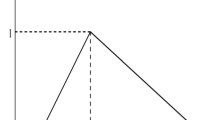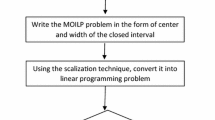Abstract
In fuzzy single and multi-objective minimal cost flow (MCF) problems, it is assumed that there is only one conveyance which can be used for transporting the product. However, in real life problems, more than one conveyance is used for transporting the product. To the best of our knowledge untill now no method is proposed in the literature for solving such fuzzy single and multi-objective MCF problems in which more than one conveyance is used for transporting the product and all the parameters, as well as all the decision variables that are represented by fuzzy numbers. In this paper, these types of fuzzy multi-objective MCF problems are called fully fuzzy multi-objective solid minimal cost flow (SMCF) problems and a new method is proposed for solving these problems. The advantages of the proposed methods are also discussed.


Similar content being viewed by others
References
Allahviranloo T, Lotfi FH, Kiasary MK, Kiani NA, Alizadeh L (2008) Solving fully fuzzy linear programming problem by the ranking function. Appl Math Sci 2:19–32
Allahviranloo T, Mikaeilvand N, Lotfi FH, Kiasari MK (2008) Fully fuzzy linear programming problem with positive or negative core. Far East J Appl Math 33:337–350
Ammar EE, Youness EA (2005) Study on multiobjective transportation problem with fuzzy numbers. Appl Math Comput 166:241–253
Baykasoglu A, Gocken T (2011) A direct solution approach to fuzzy mathematical programs with fuzzy decision variables. Expert Syst Appl. doi:10.1016/j.eswa.2011.08.047
Bit AK, Biswal MP, Alam SS (1993) Fuzzy programming approach to multiobjective solid transportation problem. Fuzzy Sets Syst 57:183–194
Buckley JJ, Feuring T (2000) Evolutionary algorithm solution to fuzzy problems: fuzzy linear programming. Fuzzy Sets Syst 109:35–53
Buckley JJ, Feuring T, Hayashi Y (2001) Multi-objective fully fuzzified linear programming. Int J Uncertain Fuzziness Knowl-Based Syst 9:605–621
Buckley JJ, Jowers LJ (2006) Simulating continuous fuzzy systems. Springer, Berlin
Cho JH, Kim HS, Choi JR (2012) An intermodal transport network planning algorithm using dynamic programming, A case study: from Busan to Rotterdam in intermodal freight routing. Appl Intell 36:529–541
Dehghan M, Hashemi B, Ghatee M (2006) Computational methods for solving fully fuzzy linear systems. Appl Math Comput 179:328–343
Dubois D, Prade H (1980) Fuzzy sets and systems: theory and applications. Academic Press, New York
Garcia MS, Lamata MT (2007) A modification of the index of Liou ad Wang for ranking fuzzy number. Int J Uncertain Fuzziness Knowl-Based Syst 15:411–424
Gen M, Ida K, Li Y, Kubota E (1995) Solving bicriteria solid transportation problem with fuzzy numbers by a genetic algorithm. Comput Ind Eng 29:537–541
Ghatee M, Hashemi SM (2008) Generalized minimal cost flow problem in fuzzy nature: an application in bus network planning problem. Appl Math Model 32:2490–2508
Ghazanfari M, Yousefli A, Jabal Ameli MS, Bozorgi-Amiri A (2009) A new approach to solve time-cost trade-off problem with fuzzy decision variables. Int J Adv Manuf Technol 42:408–414
Gupta A, Kumar A, Kaur A (2011) Mehar’s method to find exact fuzzy optimal solution of unbalanced fully fuzzy multi-objective transportation problems, optimization letters. Optimization Letters. doi:10.1007/s11590-011-0367-2
Hashemi SM, Modarres M, Nasrabadi E, Nasrabadi MM (2006) Fully fuzzified linear programming, solution and duality. J Intell Fuzzy Syst 17:253–261
Hussein ML (1998) Complete solutions of multiple objective transportation problems with possibilistic coefficients. Fuzzy Sets Syst 93:293–299
Islam S, Roy TK (2006) A new fuzzy multi-objective programming: entropy based geometric programming and its application of transportation problems. Eur J Oper Res 173:387–404
Jowers LJ, Buckley JJ, Reilly KD (2007) Simulating continuous fuzzy systems. Inf Sci 177:436–448
Kaur J, Kumar A (2012) Exact fuzzy optimal solution of fully fuzzy linear programming problems with unrestricted fuzzy variables. Appl Intell 37:145–154
Kocken HG, Ahlatcioglu M (2011) A compensatory approach to multiobjective linear transportation problem with fuzzy cost coefficients. Math Probl Eng 2011:1–19
Kumar A, Kaur A (2011) Application of classical transportation methods to find the fuzzy optimal solution of fuzzy transportation problems. Fuzzy Inf Eng 1:81–99
Kumar A, Kaur J, Singh P (2011) A new method for solving fully fuzzy linear programming problems. Appl Math Model 35:817–823
Li Y, Ida K, Gen M (1997) Improved genetic algorithm for solving multiobjective solid transportation problem with fuzzy numbers. Comput Ind Eng 33:589–592
Lotfi FH, Allahviranloo T, Jondabeha MA, Alizadeh L (2009) Solving a fully fuzzy linear programming using lexicography method and fuzzy approximate solution. Appl Math Model 33:3151–3156
Nasrabadi MM, Nasrabadi E (2004) A mathematical-programming approach to fuzzy linear regression analysis. Appl Math Comput 155:873–881
Ojha A, Das B, Mondala S, Maiti M (2009) An entropy based solid transportation problem for general fuzzy costs and time with fuzzy equality. Math Comput Model 50:166–178
Pramanik S, Roy TK (2008) Multiobjective transportation model with fuzzy parameters: priority based fuzzy goal programming approach. J Transp Syst Eng Inf Technol 8:40–48
Rommelfanger H (1996) Fuzzy linear programming and applications. Eur J Oper Res 92:512–527
Tanaka H, Asai K (1984) Fuzzy solution in fuzzy linear programming problems. IEEE Trans Syst Man Cybern 14:325–328
Tanaka H, Asai K (1984) Fuzzy linear programming problems with fuzzy numbers. Fuzzy Sets Syst 13:1–10
Tanaka H, Guo P, Zimmermann HJ (2000) Possibility distributions of fuzzy decision variables obtained from possibilistic linear programming problems. Fuzzy Sets Syst 113:323–332
Zadeh LA (1965) Fuzzy sets. Inf Control 8:338–353
Zimmermann HJ (1978) Fuzzy programming and linear programming with several objective functions. Fuzzy Sets Syst 1:45–55
Acknowledgements
The authors would like to thank to the Editor-in-Chief and anonymous referees for various suggestions which have led to an improvement in both the quality and clarity of the paper I, Dr. Amit Kumar, want to acknowledge the adolescent inner blessings of Mehar. I believe that Mehar is an angel for me and without Mehar’s blessing it would not have been possible to attain and fulfil the idea presented in this paper. Mehar is a lovely daughter of Parmpreet Kaur (Research Scholar under my supervision). The authors also acknowledge the financial support given by the University Grant Commission, Govt. of India for completing the Major Research Project (39-40/2010(SR)).
Author information
Authors and Affiliations
Corresponding author
Rights and permissions
About this article
Cite this article
Kaur, M., Kumar, A. Method for solving unbalanced fully fuzzy multi-objective solid minimal cost flow problems. Appl Intell 38, 239–254 (2013). https://doi.org/10.1007/s10489-012-0368-6
Published:
Issue Date:
DOI: https://doi.org/10.1007/s10489-012-0368-6




